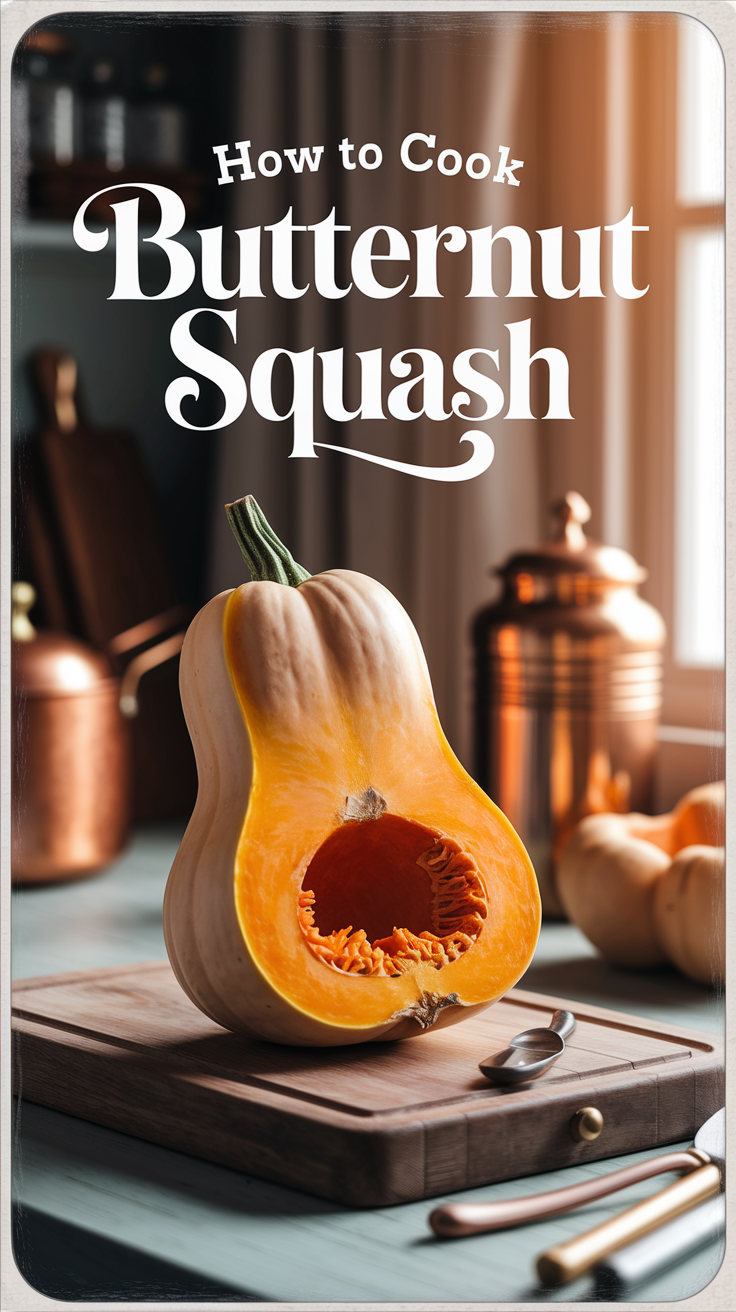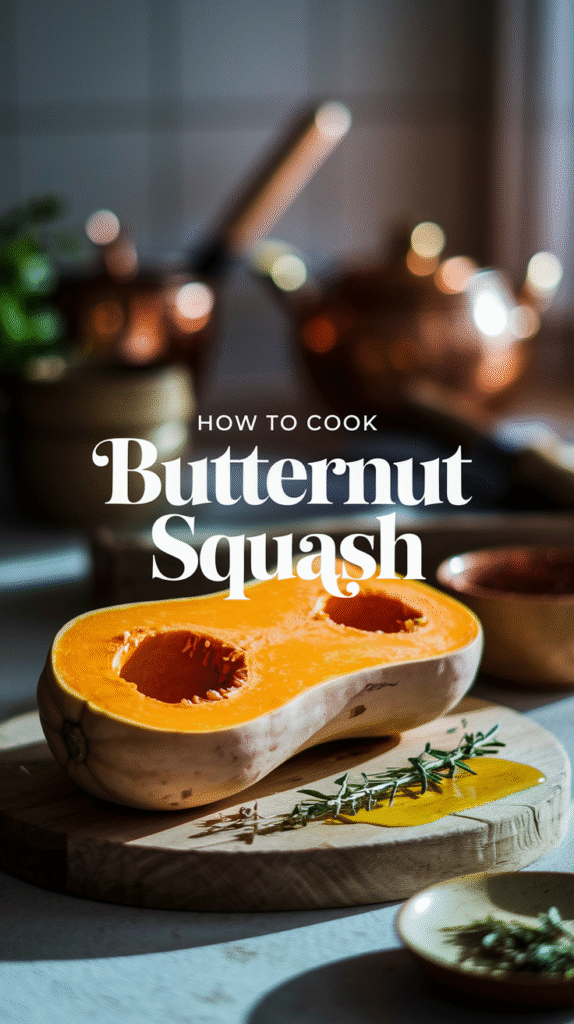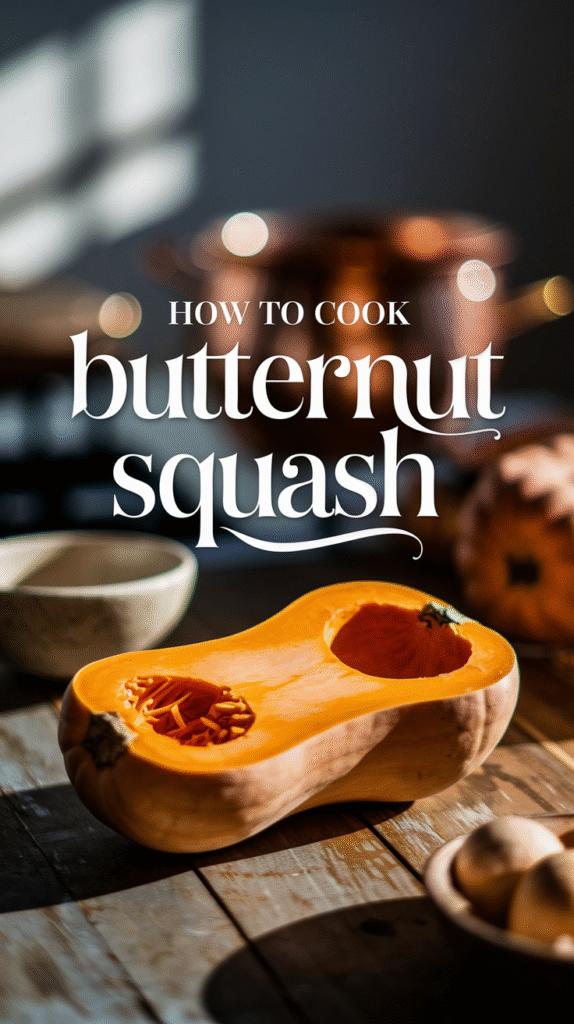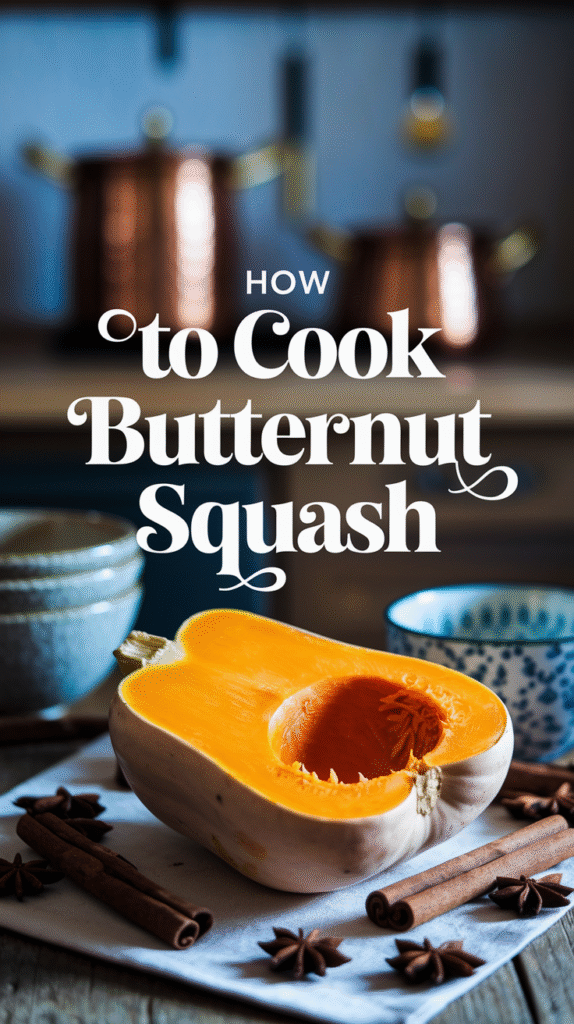Cooking butternut squash opens up a world of delicious possibilities. This sweet, nutty vegetable can take on various cooking methods, from roasting to steaming. In this guide, you’ll discover the best techniques and tips to elevate your butternut squash dishes.
Preparing Butternut Squash
Before you start cooking, proper preparation is key. Follow these steps:
- Choosing the Right Squash: Look for butternut squash that feels heavy for its size, with a smooth, firm skin and no soft spots.
- Peeling: Use a sharp vegetable peeler to remove the tough skin. If the squash is particularly hard, you can microwave it for 2-3 minutes to make it easier to handle.
- Seed Removal: Cut the squash in half lengthwise and scoop out the seeds with a spoon. You can save the seeds to roast later for a crunchy snack.
- Dicing: Cut the squash into cubes for quicker cooking or leave it in halves for roasting.
Roasting Butternut Squash
Roasting enhances the natural sweetness of butternut squash. Here’s how to perfectly roast it:
- Preheat the Oven: Set your oven to 425°F (220°C).
- Seasoning: Toss the diced squash with olive oil, salt, and pepper. Add spices like cinnamon or nutmeg for a sweeter flavor or chili powder for a kick.
- Spread On Baking Sheet: Lay the squash in a single layer on a parchment-lined baking sheet. This helps it roast evenly.
- Roasting Time: Roast for 25-30 minutes until tender and caramelized. Toss halfway through cooking for even browning.
Steaming Butternut Squash
If you prefer a lighter option, steaming is a quick and healthy method:
- Setup: Fill a pot with an inch of water and put a steamer basket inside.
- Bring to a Boil: Cover and bring the water to a boil.
- Add Squash: Place the diced butternut squash in the steamer basket. Cover with a lid.
- Steaming Time: Steam for about 10-15 minutes until tender. You can test doneness with a fork.
Mashing butternut squash
Mashed butternut squash makes a great substitute for mashed potatoes. Here’s how to prepare it:
- Cook: Either roast or steam the squash cubes until soft.
- Mash: Transfer the cooked squash to a bowl. Use a potato masher or fork to mash.
- Flavoring: Mix in butter, cream, or a splash of maple syrup, and season with salt and pepper to taste.
Butternut Squash Soup
A warm bowl of butternut squash soup is comforting and nourishing. Here’s a simple recipe:
- Ingredients:
- 1 butternut squash, peeled and cubed
- 1 onion, chopped
- 2 cloves garlic, minced
- 4 cups vegetable broth
- Salt and pepper to taste
- Optional: cream or coconut milk for creaminess
- Saute: In a large pot, sauté onion and garlic until soft.
- Add Squash and Broth: Add the cubed squash and broth. Bring to a boil and simmer until squash is tender, about 20-25 minutes.
- Blend: Use an immersion blender to puree until smooth. Adjust seasoning and stir in cream if desired.
Storing Cooked Butternut Squash
If you cook more butternut squash than you need, you can easily store it:
- Refrigerate: Store in an airtight container in the fridge for up to 5 days.
- Freeze: Freeze in freezer-safe bags for up to 3 months. Thaw before reheating.
Butternut squash is versatile and nutritious. Whether you’re roasting, steaming, or making soup, these techniques will help you appreciate this delightful vegetable. For more recipes and cooking tips, check out Eatwell101 or Food Network.
Nutritional Benefits of Butternut Squash
Butternut squash is not only delicious but also packed with nutrients that can enhance your overall health. It’s a winter squash with a sweet, nutty flavor and numerous health benefits. Understanding these nutritional benefits can help you incorporate butternut squash into your diet more effectively.
Rich in Vitamins and Minerals
This vibrant vegetable is a powerhouse of essential vitamins and minerals. Here are some of the key nutrients found in butternut squash:
- Vitamin A: Just one cup of cooked butternut squash provides over 400% of the recommended daily intake of vitamin A. This vitamin is crucial for maintaining healthy vision and supporting immune function.
- Vitamin C: Butternut squash is an excellent source of vitamin C, which acts as an antioxidant. It helps combat free radicals in the body, promoting skin health and boosting the immune system.
- Potassium: This vegetable contains potassium, which is important for regulating blood pressure and maintaining heart health.
- Magnesium: A good source of magnesium, butternut squash contributes to bone health and supports muscle and nerve function.
High in Fiber
Butternut squash is high in dietary fiber. A single cup provides around 7 grams. Fiber is essential for digestive health, helping to prevent constipation and promote a healthy gut. Including fiber-rich foods in your diet can also help you feel full longer, which is beneficial for weight management.
Low in Calories
If you’re looking to manage your weight, butternut squash is an excellent choice. It’s low in calories, with just about 82 calories per cup when cooked. This makes it a nutritious addition to meals without adding too many calories, allowing for a satisfying and healthy diet.
Rich in Antioxidants
Beyond vitamins, butternut squash is rich in antioxidants such as beta-carotene, which gives it its bright orange color. Antioxidants help fight inflammation in the body and can reduce the risk of chronic diseases such as heart disease and cancer. Foods high in antioxidants are essential for a balanced diet.
Understanding the Health Benefits
Butternut squash into your meals can offer various health benefits. Here are some of the ways it can positively impact your health:
| Health Benefit | Description |
|---|---|
| Improved Vision | Thanks to its high vitamin A content, butternut squash helps keep your eyes healthy, reducing the risk of vision problems. |
| Weight Management | Its low calorie count and high fiber content can help you feel full, making it easier to manage your weight. |
| Heart Health | Potassium and antioxidants support heart health by helping regulate blood pressure and reducing cholesterol levels. |
| Gut Health | High fiber content promotes healthy digestion, preventing constipation and maintaining gut health. |
How to Incorporate Butternut Squash into Your Diet
Adding butternut squash to your meals is straightforward and versatile. Here are a few simple ideas:
- Soups: Blend cooked butternut squash with vegetable or chicken broth for a creamy soup.
- Roasted: Dice and roast it with olive oil, salt, and pepper for a delicious side dish.
- Salads: Add roasted butternut squash to salads for a sweet and satisfying crunch.
- Purees: Mash it as a side dish or use it as a filling for pasta.
Butternut squash is not just a tasty ingredient; it’s also a nutritional powerhouse. By including this versatile squash in your meals, you can tap into its many health benefits while enjoying its delicious flavor. For more detailed nutritional information and recipes, you can visit Healthline or Eat This, Not That!.
Creative Recipe Ideas Featuring Butternut Squash
Butternut squash is a versatile ingredient that adds a sweet, nutty flavor to various dishes. It’s packed with vitamins and great for a healthy diet. If you’re looking to get creative in the kitchen, here are some innovative recipe ideas to try out.
Butternut Squash Soup
This classic dish is warming and comforting. To make a simple butternut squash soup, you’ll need:
- 1 medium butternut squash, peeled and cubed
- 1 onion, chopped
- 2 cloves of garlic, minced
- 4 cups vegetable broth
- 1 tsp cumin
- Salt and pepper to taste
- 1 cup coconut milk (optional for creaminess)
Start by sautéing the onion and garlic in a pot until golden. Add the cubed squash and broth, then bring to a boil. Reduce heat and simmer for 20 minutes, or until the squash is tender. Blend until smooth, stir in the coconut milk, and season to taste.
Roasted Butternut Squash Salad
For a hearty salad, try adding roasted butternut squash to your greens. You’ll need:
- 4 cups mixed salad greens
- 2 cups roasted butternut squash cubes
- ½ cup feta cheese, crumbled
- ½ cup walnuts, toasted
- 2 tbsp olive oil
- 2 tbsp balsamic vinegar
Toss the salad greens with roasted squash, crumbled feta, and walnuts. Drizzle with olive oil and balsamic vinegar for a delightful dressing. This salad is perfect as a side dish or a light meal!
Butternut Squash Pasta
Transform your pasta night by using butternut squash. For butternut squash pasta, you will need:
- 8 oz whole grain pasta
- 1 cup butternut squash puree (homemade or store-bought)
- 2 tbsp butter or olive oil
- ¼ cup grated parmesan cheese
- Salt and pepper to taste
- Fresh basil or parsley for garnish
Cook your pasta according to the package instructions. In a separate pan, heat the butter or oil and stir in the squash puree. Combine together, adding cheese and seasoning to taste. Serve warm, garnished with fresh herbs.
Stuffed Butternut Squash
For a filling main course, stuffed butternut squash is a great option. Here’s what you’ll need:
- 2 halved butternut squashes
- 1 cup cooked quinoa or rice
- 1 can black beans, rinsed and drained
- 1 cup corn kernels (fresh or frozen)
- 1 tsp chili powder
- 1 cup shredded cheese (optional)
Preheat your oven to 400°F (200°C). Place squash halves cut side down on a baking sheet and roast until tender. In a bowl, mix quinoa, beans, corn, chili powder, and half the cheese. Turn the squash over, fill each with the mixture, top with the remaining cheese, and bake for an additional 10 minutes.
Butternut Squash Pancakes
For a unique breakfast twist, make butternut squash pancakes! Here’s a simple recipe to try:
- 1 cup butternut squash puree
- 1 cup all-purpose flour
- 2 eggs
- 1 tbsp baking powder
- ½ cup milk
- 1 tsp cinnamon
- 2 tbsp honey or maple syrup
Mix all the ingredients to form a batter. Heat a non-stick skillet and pour in the batter, cooking until bubbles form on the surface. Flip and cook until golden. Serve with maple syrup or fruit for a delicious breakfast!
With these creative recipe ideas featuring butternut squash, you can enjoy this nutritious vegetable in multiple ways! Each recipe is not only healthy but also delicious, allowing you to explore new flavors and textures in your meals.
For more inspiration and recipes, check out Love and Lemons and Food Network.
Seasonal Cooking: Incorporating Butternut Squash into Your Meals
Butternut squash is a versatile ingredient that can elevate your meals during the fall and winter seasons. Its sweet, nutty flavor pairs well with a variety of spices and ingredients. Here’s how you can incorporate butternut squash into your meals effectively.
Choosing the Right Butternut Squash
When selecting butternut squash, look for those that are firm, heavy for their size, and have a dull skin. Avoid any with soft spots or blemishes. The color of the skin should be a rich tan, and the stem should be dry and hard, indicating freshness.
Preparation Techniques
Before you start cooking with butternut squash, proper preparation is key. Here are a few methods to prepare it:
- Peeling: Use a vegetable peeler to remove the tough skin. Be careful, as the skin can be quite thick.
- Cutting: Slice the squash in half lengthwise. Use a spoon to scoop out the seeds and stringy bits from the center.
- Dicing: Once halved, cut the squash into cubes for roasting, steaming, or adding to soups.
Cooking Methods
There are many ways you can cook butternut squash to bring out its delicious flavor.
- Roasting: This method enhances the sweetness of the squash. Simply toss cubes with olive oil, salt, and your favorite spices, such as cinnamon or paprika. Roast in a preheated oven at 400°F (200°C) for about 25-30 minutes.
- Boiling: For a quick cooking option, you can boil butternut squash cubes in water for about 10-15 minutes until tender. This method is great for purees or soups.
- Steaming: Steaming is a healthy cooking method that helps retain nutrients. Steam cubes over boiling water for about 15 minutes, or until tender.
- Pureeing: If you want to make a smooth soup or sauce, you can roast or boil the squash, then blend it until creamy. Add broth for soup or spices for sauces.
Delicious Recipes Using Butternut Squash
Here are some easy and delicious recipes featuring butternut squash:
- Butternut Squash Soup: Cook chopped onions, garlic, and cubed butternut squash in a pot with vegetable broth. Once tender, blend until smooth and season with salt, pepper, and nutmeg.
- Roasted Butternut Squash Salad: Toss roasted butternut squash with mixed greens, cranberries, walnuts, and feta cheese. Drizzle with balsamic vinaigrette for a hearty salad.
- Stuffed Butternut Squash: Halve and roast the squash. Fill it with a mixture of quinoa, black beans, corn, and spices, then bake until heated through.
Utilizing Butternut Squash in Other Meals
Aside from main dishes, you can also incorporate butternut squash into your snacks and sides:
- Butternut Squash Fries: Cut the squash into thin strips, toss with olive oil and seasonings, and bake until crispy for a healthier alternative to fries.
- Butternut Squash Pancakes: Blend cooked squash into your pancake batter for added moisture and a nutritious twist.
Storage Tips
To keep butternut squash fresh:
- Store whole squash in a cool, dark place for several weeks.
- Once cut, wrap it tightly in plastic wrap and refrigerate, using it within a few days.
For more information about seasonal cooking and recipes, check out Food Network and Cooking Light.
Butternut squash into your meals not only enhances flavor but also adds essential nutrients. Experiment with the methods and recipes above to make the most of this delicious vegetable this season!
Choosing and Storing Butternut Squash for Optimal Freshness
When it comes to enjoying butternut squash at its best, selecting the right one and storing it properly is key. With its sweet, nutty flavor and smooth texture, butternut squash is a staple in many kitchens. Here’s how to ensure you choose and store butternut squash for optimal freshness.
Choosing Butternut Squash
To find the freshest butternut squash, keep these tips in mind when you’re at the market:
- Look for a Firm Skin: The skin should feel hard and smooth, indicating that it’s ripe. Avoid any squash with soft spots or blemishes.
- Check the Color: A rich, tan color is a good sign that the squash is mature. The skin should be uniform without dark green or white patches.
- Pay Attention to Size: Choose squash that feels heavy for its size. A heavier squash typically has more flesh.
- Stems Count: Opt for squash with a stem intact, as this helps prolong its freshness. A missing stem can lead to quicker spoilage.
Taking time to select the best squash ensures that your recipes will be delicious and filled with great flavor.
Storing Butternut Squash
After selecting your butternut squash, it’s essential to store it correctly to keep it fresh longer. Here are some effective storage methods:
- Cool and Dark Location: Store your whole butternut squash in a cool, dark place, like a pantry or cellar. This helps maintain its moisture without spoiling.
- Avoid Refrigeration: Do not refrigerate butternut squash. The cold temperature can negatively impact its taste and texture.
- Use a Vegetable Crisper: If you’ve cut the squash, wrap the unused portion tightly in plastic wrap or place it in an airtight container, then store it in the refrigerator. It will last about 3-5 days.
- Freezing for Long-Term Storage: If you want to store butternut squash for an extended period, consider freezing it. Peel, cube, and steam the squash until tender, then let it cool before transferring it to a freezer-safe bag. It can be stored for up to a year!
Signs of Spoilage
Knowing when butternut squash has gone bad is crucial. Here are some signs to look for:
- Mold: If you spot mold on the skin, it’s best to discard the squash.
- Softness: A firm squash should remain firm; if it feels soft all over, it’s no longer fresh.
- Unpleasant Odor: A sour smell is an indicator of spoilage.
Fun Ways to Use Butternut Squash
The versatility of butternut squash makes it a favorite among many home cooks. Here are some creative ways to incorporate this nutrient-rich vegetable into your meals:
- Soups: Butternut squash soup is creamy and flavorful, perfect for chilly nights.
- Roasting: Slice and roast the squash with herbs and spices for a delicious side dish.
- Purees: Use it in baby food or as a healthy base for sauces.
- Salads: Toss roasted butternut squash into salads for added texture and nutrients.
By selecting the right butternut squash and knowing how to store it properly, you can enjoy its flavors and benefits for weeks. Don’t forget to explore different recipes and ways to incorporate this delicious squash into your meals!
For more information about butternut squash varieties and recipes, check out the Epicurious Butternut Squash Guide.
For helpful tips on cooking and utilizing squash in your diet, visit Food Network’s Butternut Squash Ideas.
Conclusion
Butternut squash is not only a versatile and delicious ingredient but also a powerhouse of nutrition. By mastering various cooking techniques such as roasting, steaming, and pureeing, you can enhance its naturally sweet flavor and create appealing dishes. Keep in mind the wealth of vitamins and minerals packed into this vibrant squash, making it a fantastic addition to a healthy diet.
Exploring creative recipe ideas enables you to enjoy butternut squash in a myriad of ways, whether in savory soups, hearty risottos, or delightful desserts. Integrating seasonal cooking, such as using fresh squash during the autumn months, adds warmth and comfort to your meals while emphasizing flavors that are in harmony with the season.
When it comes to selecting butternut squash, knowing what to look for in terms of appearance and firmness is essential. Proper storage further ensures your squash remains fresh and ready to use. By following these simple yet effective tips, you can elevate your cooking experience and make the most out of this nutritious vegetable.
With its rich taste, health benefits, and endless culinary possibilities, butternut squash deserves a prominent place on your plate. So grab a squash, get creative in your kitchen, and enjoy the delightful flavors it brings to your meals. Happy cooking!







Leave a Reply